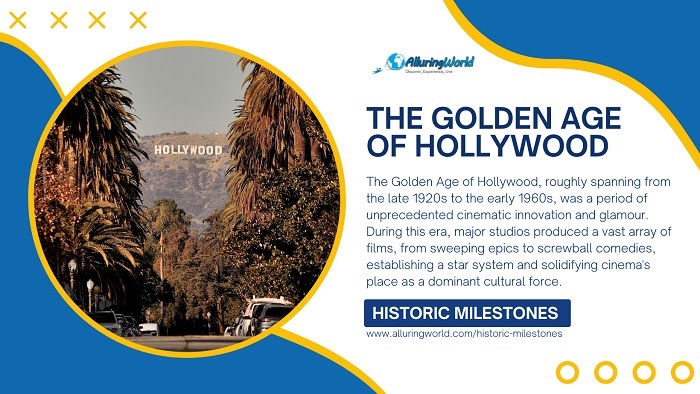Read time ca. 5 minutes
The Golden Age of Hollywood is a period that generally spans from the late 1920s with the advent of synchronized sound to the early 1960s, and it represents a transformative era in American cinema. This period saw the rise of the studio system which was a highly efficient and prolific production model that churned out hundreds of films annually, establishing Hollywood as the global epicenter of filmmaking. During this time, iconic stars were born, memorable genres flourished, and the magic of the big screen captivated audiences worldwide, leaving an indelible mark on popular culture and the art of storytelling.
A Dazzling Era of Film and Glamour:
Fundamentally characterized by the rise of the studio system, in particular following the groundbreaking introduction of synchronized sound in 1927 with films like The Jazz Singer, Hollywood majors such as MGM, Warner Bros., Paramount, RKO, and 20th Century Fox established a vertically integrated model. This meant these powerful studios managed every facet of filmmaking which started with the initial concept and production up to the distribution and exhibition, effectively creating a highly efficient factory for movie-making.
This dominant studio structure not only fostered unprecedented cinematic output but also cultivated a unique blend of artistry and commerce. It was within this environment that the concept of the movie star truly solidified because studios were nurturing and promoting larger-than-life personalities who captivated audiences that watched the motion pictures. The films produced during this period were from across various genres and they have profoundly influenced storytelling conventions by laying much of the groundwork for modern cinema, leaving an enduring legacy on global popular culture.
The Studio System and the Rise of Stars:
At the heart of this golden era was the star system, a carefully crafted machine that manufactured fame for the regular people to adore and admire. Actors and actresses were often signed to long-term contracts with studios, which meticulously managed their public personas. This era saw the emergence of screen legends such as Humphrey Bogart, Bette Davis, Cary Grant, Katharine Hepburn, Clark Gable, and Marilyn Monroe. These stars were not only performers but cultural icons who shaped fashion, language, and public attitudes. Studios carefully controlled film genres and churned out a steady stream of musicals, westerns, romantic dramas, war films, and noir thrillers that captivated audiences.
Cinematic Innovation and Cultural Impact:
Hollywood’s Golden Age was a period of constant technological advancement that profoundly transformed the movie-going experience. Early advancements moved beyond rudimentary black-and-white visuals to the vivid hues of Technicolor, dramatically altering the aesthetic possibilities of film, and similarly, the evolution from basic monaural sound to richer, more intricate soundscapes immersed audiences more deeply in the cinematic narrative. This relentless pursuit of innovation not only refined the technical quality of films but also broadened the creative scope for filmmakers, leading to a more dynamic and engaging form of entertainment.
Beyond their artistic and technical merits, films from this era served as powerful cultural touchstones, actively engaging with and influencing American society. Masterpieces such as Gone with the Wind, Casablanca, Citizen Kane, and Singin’ in the Rain not only established new benchmarks for storytelling and genre conventions but also mirrored the societal shifts of their time. During World War II, the industry leveraged its influence to produce patriotic narratives that bolstered public morale, nevertheless, in the post-war years, as the nation grappled with new complexities, Hollywood responded by exploring more nuanced themes through the emergence of film noir and compelling social dramas, reflecting a deepening introspection within American culture.
Challenges and the Decline of the Studio System:
While often romanticized, this majestic period of Hollywood wasn’t without its complexities and challenges. A significant point of contention was the restrictive nature of studio contracts, which often afforded actors minimal creative autonomy. Furthermore, the pervasive influence of the Motion Picture Production Code imposed stringent censorship, significantly limiting the range and depth of narratives that could be explored on screen. These internal pressures highlighted a less glamorous side of the era, where artistic expression was often subject to corporate and moralistic control.
Still, the post-war period brought about substantial shifts that ultimately heralded the end of this cinematic era. A pivotal moment arrived with the 1948 U.S. Supreme Court decision in United States v. Paramount Pictures, which effectively dismantled the studios’ monopolistic control by compelling them to divest their theater chains. This legal ruling fundamentally altered the distribution landscape, concurrently, the burgeoning popularity of television in the 1950s drew audiences away from movie theaters, leading to a noticeable decline in attendance. By the early 1960s there was a new wave of independent filmmaking that began to emerge, often tackling more socially conscious themes, signifying a profound change in Hollywood’s approach to storytelling and marking the twilight of its golden era.
Conclusion:
Overall, the Golden Age of Hollywood remains a defining chapter in the history of global cinema. It gave the world timeless films, unforgettable stars, and storytelling techniques that continue to influence filmmakers today. Beyond the glitz and glamour, it was a time of bold artistic innovation, industry transformation, and deep cultural resonance. Though the studio system eventually faded, the legacy of this era still flickers brightly on screens, echoing a time when Hollywood truly ruled the silver screen.

